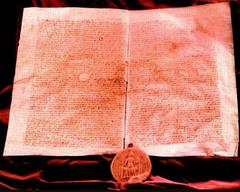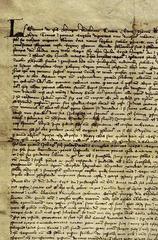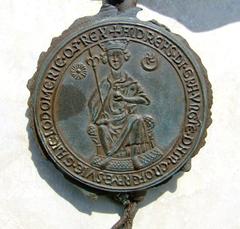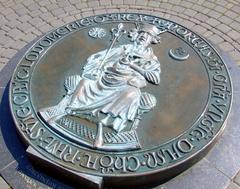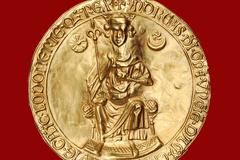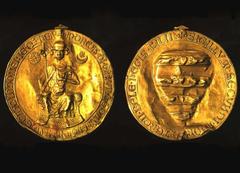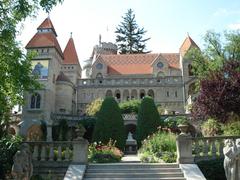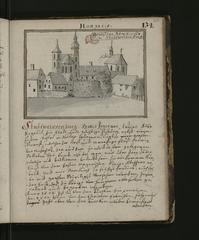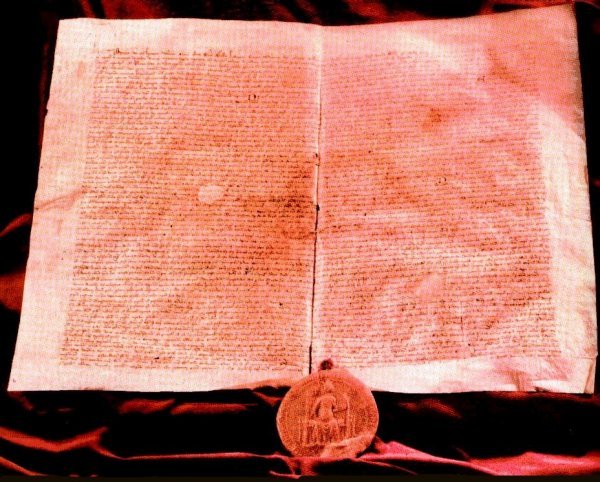
Golden Bull of 1222 Monument Visiting Hours, Tickets, and Historical Significance in Székesfehérvár, Hungary
Date: 14/06/2025
Introduction
Located in the historic city of Székesfehérvár, Hungary, the Golden Bull of 1222 Monument stands as a powerful symbol of Hungarian constitutional heritage. Often compared to England’s Magna Carta, the Golden Bull marks the moment when King Andrew II codified noble rights and introduced limits to royal power, shaping the medieval governance of Hungary. Székesfehérvár—once the seat of Hungarian kings—provides a fitting backdrop for this monument, offering visitors a deep dive into the nation’s legal and political evolution (Trespasser on Earth, visitsights.com, FehervarNeked).
This guide presents a detailed overview of the monument’s historical context and significance, alongside practical visitor information—including opening hours, ticketing, accessibility, nearby attractions, and special events. Whether you’re a history enthusiast, cultural traveler, or simply curious about the legacy of justice and liberty in Hungary, Székesfehérvár’s Golden Bull Monument offers an immersive experience.
Table of Contents
- Historical Background: The Golden Bull of 1222
- Székesfehérvár’s Role in Hungarian Statehood
- Visiting the Golden Bull Monument and Related Sites
- Monument Description and Artistic Features
- Location and Getting There
- Nearby Attractions and Suggested Itineraries
- Essential Visitor Tips
- Frequently Asked Questions (FAQ)
- References and Further Reading
Historical Background: The Golden Bull of 1222
The Golden Bull of 1222 (Aranybulla) is a foundational charter in Hungarian constitutional history, issued by King Andrew II in Székesfehérvár. It was created at a time of social tension, as the king’s extensive land grants to foreign supporters weakened royal authority and sparked discontent among the native nobility and clergy (Trespasser on Earth).
Key Provisions
- Recognition of Noble Rights: Codified noble privileges, including property rights and tax exemptions.
- Limitation of Royal Power: Restricted the king’s ability to make land grants to foreigners or levy extraordinary taxes without noble consent.
- Resistance Clause: Introduced the legal right for nobles to resist the king if he violated the charter, an unprecedented check on royal authority.
- Economic and Military Regulations: Protected the nobility’s economic interests and regulated military service obligations.
The Golden Bull’s principles endured for centuries, reaffirmed by subsequent monarchs and remaining influential well into the modern era (Trespasser on Earth, Britannica).
Székesfehérvár’s Role in Hungarian Statehood
Székesfehérvár was the medieval capital of Hungary, the site of royal coronations, and a frequent venue for assemblies and legislative gatherings (Panadea). The city’s basilica, once one of Europe’s largest churches, symbolized the unity of crown, church, and nobility. The choice to promulgate the Golden Bull here further anchored Székesfehérvár as a cradle of Hungarian statehood.
Today, monuments such as the Országalma (Country Apple) and the Golden Bull Monument celebrate this legacy, making Székesfehérvár a living museum of Hungary’s constitutional journey (Trespasser on Earth).
Visiting the Golden Bull Monument and Related Sites
Visiting Hours and Tickets
- Golden Bull Monument (Öreghegy District): Open-air site, accessible 24/7, year-round. No entrance fee or tickets required (FehervarNeked).
- Medieval Ruin Garden (Középkori Romkert): Daily, 9:00 AM – 6:00 PM (last entry at 5:30 PM). Tickets approx. 1,200 HUF for adults; discounts for students and seniors (visitsights.com).
- Országalma Monument: Outdoor public space, accessible at all times.
Guided Tours and Exhibitions
- Guided walking and cycling tours are available through local operators and the Székesfehérvár Tourinform office (Tourinform Website).
- Multilingual audio guides and virtual tours can be arranged.
- Museum exhibitions in the city center offer deeper insights and artifacts relating to the Golden Bull.
Accessibility and Travel
- The monument is accessible by foot, bike, car, or public transport.
- Paved paths and ramps accommodate visitors with limited mobility, though a moderate uphill walk is required to reach the hilltop site (Touristlink).
- Székesfehérvár is approximately 65 km (1 hour) from Budapest by train or car.
Special Events
- Golden Bull Anniversary (April 24): Annual commemorations include official ceremonies, speeches, and wreath-laying (Feol.hu).
- Coronation Celebration Games: Historical reenactments and medieval fairs celebrate the city’s royal heritage.
Monument Description and Artistic Features
Created by Sándor Rétfalvi in 1972 and relocated to its present site in 1990, the Golden Bull Monument is a minimalist limestone sculpture inscribed with the charter’s core message: “No one shall be deprived of his property acquired through worthy service.” The design evokes the original golden seal and features a landscaped park setting, providing a tranquil space for reflection (FehervarNeked, Touristlink).
Location and Getting There
- Address: Öreghegy, Székesfehérvár, Hungary
- GPS: Approx. 47.1940° N, 18.4100° E
- Access: Local buses, taxis, or a moderate uphill walk from the city center
- Tourinform Office: Oskola utca 2-4, weekdays 9:00–17:00 in the off-season; provides maps and guidance (FehervarNeked)
Nearby Attractions and Suggested Itineraries
- Bory Castle: Early 20th-century architectural marvel (Audiala)
- King Stephen Museum: Artifacts from Hungary’s medieval period (Audiala)
- Basilica Ruins: Remnants of the medieval coronation church
- Historic City Center: Baroque and medieval streets, squares, and cafés
A suggested itinerary might include a morning visit to the monument, followed by city center exploration, museum visits, and lunch at a local restaurant.
Essential Visitor Tips
- Best visiting times: Spring and autumn for mild weather and fewer crowds.
- Photography: The monument’s hilltop location offers panoramic views—ideal during sunrise or sunset.
- Accessibility: Wear comfortable shoes for the uphill walk.
- Commemorations: April 24 events are open to the public and provide a unique cultural experience.
- Respect: The monument is a site of national importance; maintain decorum, especially during ceremonies.
Frequently Asked Questions (FAQ)
Q: What are the Golden Bull Monument visiting hours?
A: The monument is outdoors and accessible 24/7.
Q: Is there an entrance fee?
A: No, visiting the monument is free.
Q: How do I get to the Golden Bull Monument from Budapest?
A: Take a train or bus to Székesfehérvár (about 1 hour), then a local bus, taxi, or walk to the Öreghegy district.
Q: Are guided tours available?
A: Local walking and cycling tours often include the monument; check with the Tourinform office for options.
Q: Is the monument accessible for visitors with disabilities?
A: The park is accessible, though the approach involves an uphill walk.
Q: Where can I find more information?
A: Visit the Tourinform Office or check FehervarNeked.
References and Further Reading
- Trespasser on Earth: The Golden Bull of 1222
- visitsights.com: Golden Bull of 1222
- FehervarNeked: Golden Bull Monument
- Hungary Today: The Golden Bull - Hungary’s First Constitutional Document from 1222
- Feol.hu: Aranybulla Commemoration
- Ancient Origins: The Golden Bull of 1222
- Panadea: Székesfehérvár Travel Guide
- Touristlink: Golden Bull Memorial Overview
- Turizmus Székesfehérvár: Golden Bull Monument Details
Conclusion
The Golden Bull of 1222 Monument in Székesfehérvár is more than a historical marker—it’s a living testament to Hungary’s pursuit of justice, liberty, and constitutional governance. By visiting this landmark and its companion sites, travelers gain insight into the enduring ideals that shaped Hungarian history. Take advantage of guided tours, commemorative events, and local hospitality for a truly memorable experience. For up-to-date information, utilize resources like the Audiala app and the city’s tourism services.
